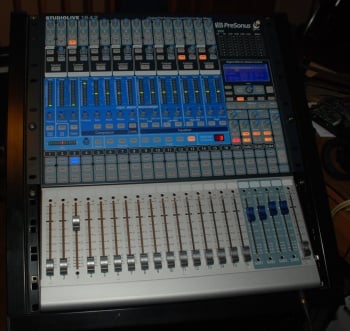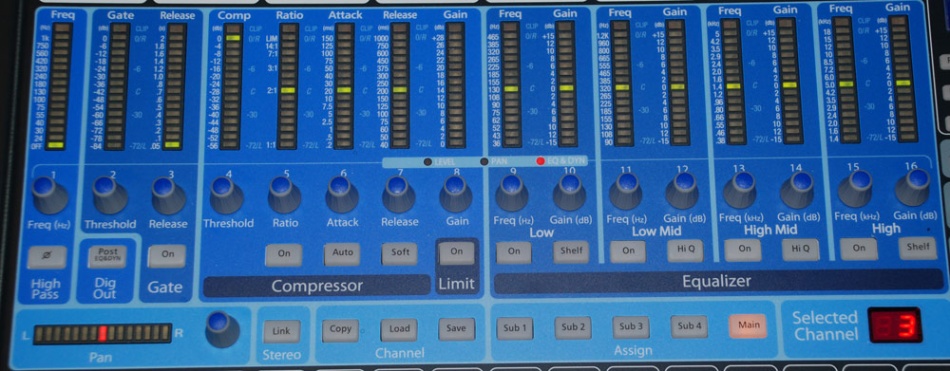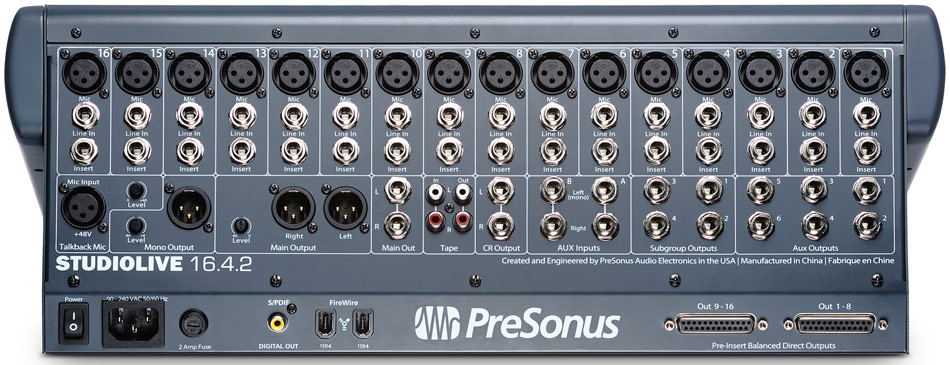Presonus Studiolive 16/4/2
Contents |
General Information
Original Author: Staffay
Weapon: Live/Studio Mixer with integrated soundcard
Make: Presonus
Model: Studiolive 16/4/2
Price: 2500€
Introduction
Presonus is an american company that manufactures mostly studio products in the semi-professional range, and are known for their Firestudio series of soundcards as well as good prizes vs. features on their products. StudioLive is a unique product since it has both a digital mixer and a 16-channel soundcard, making it extremely versatile in both handling and feature-wise. It has not really any competitors on the market, since You have to buy a separate mixer, audio-interface + soundcard for the digital mixers available. But a good guess is that the other manufacturers will follow this trend, since it really is built for musicians on the move, and enables You to record Your live-concerts as well as doing pre-productions in Your own home with the same equipment.
Technical Description
The heart of this machine is really the "Fat-channel", which is a combined gate, compressor, four band parametric EQ, High-pass filter and limiter. This features can be used on all channels & busses all over the mixer. It is connected to a computer via FireWire and all channels, busses etc. can be sent and received via a 32*18 interface. It has 16 mic/line XMAX preamps which have been borrowed from the FireStudio series, these have plenty of headroom and are quite as a mice. There is 6 AUX-channels available for using with effects/monitor -systems as well as a talkback system that works on all auxes + main. On the master-bus also sits an overall 31-band EQ to adjust to overall sound for Your PA-speakers/studio monitors. An outstanding feature is that You can store a mix-setup as a "scene", which means that with a push of a button, You can recall Your bands live-settings for every parameter on the entire console.
There are, in addition to this, two separate digital effects which can be routed anywhere in the signal-flow. It has S/PDIF outputs as well as balanced pre-fader outputs for routing to other environments. There are insert points on every channel as well as direct outputs, that can be routed before or after the "fat-channnel". What it doesn't have though, is ADAT-compatible interface or any type of synchronization features (which may be implemented later by firmware updates and some additional hardware). There is solo-in-place functions for studio-use as well as normal solo for stage use, which can be switchable by just pushing and holding a button. The mixer is a small piece of gear and sits easily on top of a standard rack unit. A point of interest also is that this piece of gear operates internaly on a 32-bit floating point frequency.
The soundcard part of this gear has also borrowed its AD/DA converters from the Firestudio series and have a very good conversion and dynamic range contrary to their price, of course there are better converters available, but then You have to pay twice as much for just a pair of converters vs. what this gear costs. Comparing to converters in the same price-range I found them as good as the other manufacturers. The card supports sample rates of 44.1 and 48 kHZ, which may be annoying to some - where did the 96 kHx and 192 kHz go???? This is however not an issue, since these frequencies are mostly used for advanced mastering and maybe in high-end studios with outboard gear that can operate on these frequencies.
In Use
Since I'm a quite experienced engineer myself and have worked a lot with different consoles, I must say that this one was not hard at all for me to handle, everything is quite logical and there is a good manual as well as a very informative support & forum pages at Presonus homepage. To get it up and running is a piece of cake, the only matter that was a little bit confusing at first were the metering and operating of the aux & effects channels. Since it's a FireWire device there's some precautions that must be made in order to make it work with a lap-top since that is actually what You wanna do in a live situation. (computer-wise) Bundled with the console is Capture, a simple application used for just capture live recordings. The files can thereafter be imported into any DAW for further processing with the StudioLive as the sound-engine.
One interesting point here is that You can actually use Your DAW-effects for live usage since the FireWire streams in both directions in real-time. Also You can use pre-recorded tracks to team up with the band in a live situation since recording and playback can be done simoultaneusly with the easy-to-go Capture software. One outstanding feature is that in a live-situation you can select whether to dump the sound to the computer before or after the fat-channel, since most people may just want to have the sound that is coming from the mics and the pre-amps with no EQ, effects and so on.
In a studio situation, You will probably go for a "hybrid" way of mixing. Since the parameters of the console itself is not automateable via MIDI, a good suggestion will be to automate levels, DAW-effects etc. from the DAW itself and then do some of the mixing the "good-ole-way" on the console and then record back the total mix to the DAW for mastering. Full automation and fader-automation can be found on other digital boards, but again - then we are talking bout' twice as much money. Presonus has announced that some parameters might be automatable via a Firmware update in the future, and that this will work with their own new DAW Studio One.
So I found this gear easy to use, a drawback might be that the faders that feels a little bit "plastic". Once You get the system up and running it works just great! Another bonus from Presonus that comes with the desk, is a real recording made of a live band that You can play around with to discover what this desk is capable of. A guy at a forum I read, stated that he have paid the cost for the whole desk in three weeks by just doing live-recordings for his friends and the day after selling back CD's to the bands.....
Sound
This is a very clean sounding and transparent desk. It just takes the sound as it really is and adds no colour as far as I can see. I compared it sound-wise to my TC Konnekt 48 card, and cannot hear any bigger differences. Compared to an old analog desk as a Soundcraft or a Studiomaster and such, it may lack some warmth - but so does all hardware in the digital domain. This can be easily fixed both live and in studio with a two-channel tube-compressor or similar and is not really an issue, rather a matter of taste. The fat-channels sounds terrific and comes with a lot of presets for vocals, guitars, percussion, basses etc. making it a breeze to initially set up a channel strip. Even the headphone amps have enough gain, something that usually would be a matter on consoles. Soundwise it is very well comparable to both Yamaha's and Soundcrafts desks within the same semi-professional range.
Overall Impression
Since I've been keeping my eyes open for this desk since it was presented at NAMM 2008, I will say that this piece of gear really holds what it promises. It might very well be the product of the year among the Studio magazines. It is truly revolutionary and never before have those set of features been available to such a low prize. It's just a dream to work with and You dont really need anything else than a computer (and some mics of course) to make a full-fledge recording that sounds very good. This is a wet dream for every serious musician who wants to be able to record both live and in the studio without having to spend a fortune.
Alternative Weapon
There is really no competition in this prize range. If You shall get the same features, it has to be Yamaha 01v96, Soundcraft, Allen & Heaths hybrid analog/digital desk, but then You dont have any fat-channels, You have to buy additional interfaces and so on.....
More Info
Reviews:
Specifications
(taken from Presonus homepage)
Computer system requirements: Below are the minimum computer-system requirements for your StudioLive 16.4.2.
Windows
Windows XP SP2 (32- or 64-bit) or later or Vista (32- or 64-bit; 64-bit requires driver version 3.4.1 or later)
Intel Pentium 4 1.6 GHz processor or AMD Athlon 64 (Turion) (2.5 GHz or faster recommended)
1 GB RAM (2 GB or more recommended)
Macintosh Mac OS X 10.4.11 or Mac OS X 10.5.2 or later (10.6 supported in driver version 3.4.2) PowerPC G4 1.25 GHz or Intel Core Solo 1.5 GHz processor (2 GHz or faster recommended) 1 GB RAM (2 GB or more recommended)
Windows and Macintosh Systems
IEEE 1394 FireWire 400 Port
Internet connection recommended
DVD-ROM drive
Internal or external 7200 RPM storage drive highly recommended
Note that the speed of your processor, amount of RAM and size and speed of your hard drive will greatly affect the overall performance of your recording system. Also, a more powerful system (faster processor with more RAM) will allow for lower latency (signal delay) that you might experience while monitoring audio or MIDI signals.
Monitor resolution for both PC and Macintosh should be no lower than 1024x768 pixels.
Microphone Preamp 1-16 (XLR Balanced)
Type XLR Female, Balanced Frequency Response to Direct Output 20 Hz to 40 kHz ±0.5dBu Frequency Response to Main Output 20 Hz to 20 kHz ±0.5dBu Input Impedance (Balanced) 1 Ohm THD to Direct Output < 0.005%, +4dBu, 20-20kHz, unity gain, unwtd THD to Main Output) <0.005%, +4 dBu, 20-20 kHz, unity gain, unwtd EIN to Direct Output +125 dB unwtd,, +130 dB A-wtd S/N Ratio to Direct Output -97 dB S/N Ratio to Main Output -94 dB Common Mode Rejection Ratio +65 dB Gain Control Range -16 dB to +67 dB (+/- 1 dB) Maximum Input Level (unity gain) +16 dBu Phantom Power +48 VDC
Line Inputs
Type 1/4" TRS Female, balanced mono Frequency Response to Direct Outputs 10-40 kHz, 0 / -0.5 dBu Frequency Response to Main Outputs 20-20 kHz, +/- 0.5 dBu Input Impedance 10 kΩ THD to Direct Output <0.0007%, +4 dBu, 20-20 kHz, unity gain, unwtd THD to Main Output <0.005%, +4 dBu, 20-20 kHz, unity gain, unwtd S/N Ratio to Direct Output -105 dB S/N Ratio to Main Output -94 dB Gain Control Range -20 dB to +20 dB (+/- 1 dB) Maximum Input level (unity gain) +22 dBu
Tape Inputs
Type 1/4” TRS Female, balanced mono Maximum Input Level +22 dBu
Auxiliary Inputs
Type 1/4” TRS Female, balanced (2 stereo pairs) Maximum Input Level +22 dBu
Main Outputs
Type Male, balanced (stereo pair); 1/4” TRS Female, balanced (stereo pair); XLR Male, balanced (mono) Rated Output Level +24 dBu Output Impedance 10 kΩ
Aux Outputs
Type 1/4” TRS Female, balanced (mono) Rated Output Level +18 dBu Output Impedance 51 Ω
Subgroup Outputs
Type 1/4” TRS Female, balanced (mono) Rated Output Level +18 dBu Output Impedance 51 Ω
Tape Outputs
Type RCA Female, unbalanced (stereo pair) Rated Output Level +18 dBu Output Impedance 100 Ω
Control Room Outputs
Type 1/4” TRS Female, balanced (stereo pair) Rated Output Level +18 dBu Output Impedance 51 Ω
System Cross Talk
Input to Output -90 dBu Adjacent Channels -87 dBu
Noise Gate / Expander
Threshold Range -84 dB to 0 dB Attack Time 0.5 ms Release Time 0.05s to 2s Expander Attenuation Range 2:1 Noise Gate Attenuation Range ∞
Compressor
Threshold Range -56 dB to 0 dB Ratio 1:1 to 14:1 Attack Time 0.2 ms to 150 ms Release Time 40 ms to 1000 ms Auto Attack and Release Attack = 10 ms, Release = 150 ms Curve Types hard and soft knee
EQ
Type 2nd order shelving filter (Q = 0.55) Low (Lowpass or Bandpass) 36 to 465 Hz, ± 15 dB Low Mid 90 Hz to 1.2 kHz, ±15 dB High Mid 380 Hz to 5 kHz, ±15 dB High (Highpass or Bandpass) 1.4 kHz to 18 kHz, ±15 dB
Digital Audio
ADC Dynamic Range (A-wtd, 48 kHz) 118 dB DAC Dynamic Range (A-wtd, 48 kHz) 118 dB FireWire S400, 400Mb/s Internal Processing 32-bit, floating point Sampling Rate 44.1, 48 kHz A/D/A Bit Depth 24 Reference Level for 0 dBFS -18 dBu
Clock
Jitter <20 ps RMS (20 Hz - 20 kHz) Jitter Attenuation >60 dB (1 ns in ≈ 1 ps out)
Power
Connector IEC Input-Voltage Range 90 to 240 VAC (factory-configured for country of destination) Power Requirements (continuous) 100 W
Physical
Length 22.35 inches (568.06 mm) Width (chassis only) 17.22 inches (437.40 mm) Width (with rack ears) 19 inches (482.60 mm) Maximum Height 6.90 inches (175.26 mm) Weight 23 lbs.








